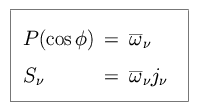Case III - To your scattered bodies go
Consider the case where the emission coefficient j is fueled purely by scattering.
An example is the reflection of sunlight to Earth from another planet. The
reflected sunlight is I
is fueled purely by scattering.
An example is the reflection of sunlight to Earth from another planet. The
reflected sunlight is I (cos
(cos  ), where
), where  is the scattering or phase angle
between the light of sight and the incident radiation (approximately zero for
the giant planets).
is the scattering or phase angle
between the light of sight and the incident radiation (approximately zero for
the giant planets).
Scattering removes radiation from a particular direction and redirects it
onto another path. If photons undergo only one encounter with a particle,
the process is referred to as single scattering; multiple
scattering refers to multiple encounters. The angular distribution of the
scattered radiation is given by the scattering phase function P (cos  ), which is by definition normalized
such that, when integrated over a sphere,
), which is by definition normalized
such that, when integrated over a sphere,
We define 
 as the albedo for single
scattering; it represents the fraction of incident radiation lost due to
scattering. It is equal to unity if the mass absorption coefficient
as the albedo for single
scattering; it represents the fraction of incident radiation lost due to
scattering. It is equal to unity if the mass absorption coefficient

 is equal to zero. The source function
S
is equal to zero. The source function
S can be written as
can be written as
Here are a few common scattering phase functions.
- Isotropic scattering: in which case
- Rayleigh scattering: the scattering of sunlight by air molecules,
- First-order anisotropic scattering: in this case, the scattering
is isotropic if qph = 0; the radiation is back-scattered if
qph > 0; the radiation is scattered forwards if qph <
0. Flux is scattered predominantly in the forward direction if the particles
are similar in size or slightly larger than the wavelength of the scattered
light.
 is fueled purely by scattering.
An example is the reflection of sunlight to Earth from another planet. The
reflected sunlight is I
is fueled purely by scattering.
An example is the reflection of sunlight to Earth from another planet. The
reflected sunlight is I (cos
(cos  ), where
), where  is the scattering or phase angle
between the light of sight and the incident radiation (approximately zero for
the giant planets).
is the scattering or phase angle
between the light of sight and the incident radiation (approximately zero for
the giant planets).






